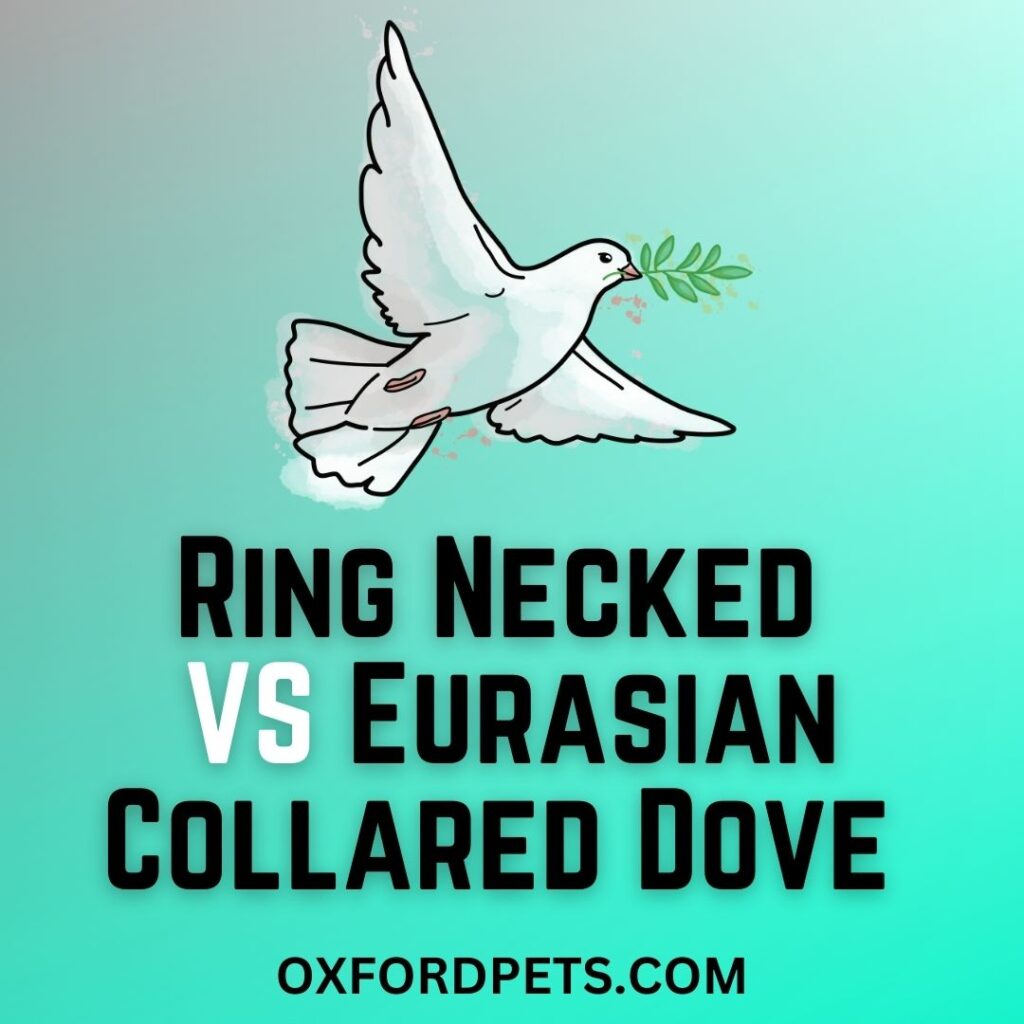Hey there, bird enthusiasts! Are you familiar with the Ring-Necked Dove and the Eurasian Collared Dove? Join us as we take a closer look at these two amazing birds.
These feathered friends might seem similar at first glance, but they each have their own special traits. Imagine the Ring-Necked Dove with its soft cooing and lovely feathers, and then meet the Eurasian Collared Dove with its fancy collar-like marking and graceful way of flying.
Both the Ring-Necked Dove and the Eurasian Collared Dove may have some similarities, but they have their own personalities. The Ring-Necked Dove is kind of like the gentle dancer of the bird world, showing off during courtship. At the same time, the Eurasian Collared Dove loves hanging out with its buddies in big groups.
If your curiosity is fueled enough, then dive into learning more about these charming creatures. Let us take you into the fascinating world of doves.
Ring Necked Dove VS Eurasian Collared Dove Appearance
Meet the Eurasian Collared Dove; this avian is like the larger, stockier cousin of the Mourning Dove. The Eurasian Collared Dove has a bit more meat on their bones. They have their cool black collar right around their neck.
On the other hand, the Ring-Necked Dove is sleek and slender. It’s like the supermodel of doves, with its graceful build. But that’s not all; when the Ring Necked Dove opens its beak, you’ll hear this beautiful “whistle” sound.
It’s like it’s striking a pose and singing a tune all at once. The Eurasian Collared Dove rocks the bold collar, while the Ring-Necked Dove charms with its slender grace and musical calls.
In short, Eurasian Collared Dove is a little chunkier, whereas Ring Necked Dove is sleek and fine in appearance. Both the birds beautifully show off their personalities!
Ring Necked Dove VS Eurasian Collared Dove Origin
Eurasian Collared Dove is a well-traveled bird from Europe and Asia. Whereas on the other side of the globe, the Ring-Necked Dove, also known as, is native to Africa and parts of southern Europe.
Ring Necked Dove VS Eurasian Collared Dove Behavior
The Eurasian Collared Dove has a very easygoing behavior, and these birds can fit in anywhere. They are adaptable and will happily call both the city and the countryside their home.
Whereas, contrary to them, the Ring-Necked Dove is kind of like a sensitive soul. These avian prefers the peaceful vibes of nature and loves to hang out in open fields or forests. Ring Necked Dove is more like the bird version of a nature retreat enthusiast.
Behaviour-wise, both Eurasian Collared Dove and Ring Necked Dove have their unique characteristics, and none share a feather or two of similarity. It is easy to spot the Eurasian Collared Dove from a mile away, chilling wherever. Whereas the Mourning Dove always finds solace in the heart of nature.

Ring Necked Dove VS Eurasian Collared Dove Habitat and Distribution
The Ring-Necked Dove is also known as the African Collared Dove. These avians are native to a vast range across sub-Saharan Africa and parts of the Arabian Peninsula. They survive in a range of habitats, including urban areas, farmlands, savannas, and grasslands. The Ring-Necked Dove has the adaptability to inhabit diverse environments from cities to towns and even open woodlands very easily. For foraging, these birds typically seek out areas with a mix of open spaces, and for perching, they seek trees.
The Eurasian Collared Dove, originally from Europe and Asia, has managed to expand its range significantly due to its adaptability and human-driven changes in habitat. Eurasian Collared Dove can also be found in parts of New Zealand, Australia as well as South America, and North America.
These birds are highly versatile and are known for their ability to thrive in both urban and rural environments. The Eurasian Collared Dove has a preference for areas that offer easy access to food sources. These birds are commonly found in gardens, parks, towns, and agricultural landscapes.

Ring Necked Dove VS Eurasian Collared Dove Breeding Behavior and Reproduction
When it comes to mating, the Ring-Necked Dove knows how to put on a show. These birds exhibit elaborate courtship involving cooing serenades, puffing up their feathers, graceful dances, and more. They tend to perch close to each other and engage in synchronized movements.
Both male and female Ring Necked Dove built nests using twigs and leaves and are situated on branches or in shrubs. The female Ring Necked Dove lays one or two eggs, and both parents take turns incubating them. As two weeks pass, the eggs start to hatch, and both males and females care for their chicks together.
The chicks fledge in about two weeks, but they still rely on their parents for food and protection for a while.
Whereas, the mating, breeding, and reproduction process amongst the Eurasian Collared Dove is a bit more straightforward. They make up practical nesting habits instead of any fancy mating efforts. This avian built their nest using grass and twigs in trees, shrubs, ledges, buildings, and other man-made structures as well.
The female Eurasian Collared Dove lays a pair of eggs, whereas both male and female share the incubation duties. After about two weeks, the eggs hatch, and the parents feed their chicks a special ‘pigeon milk,’ a secretion produced in their crop. This nutritious liquid helps birds grow healthy and rapidly. As the young doves become independent in a few weeks, they are ready to explore the world.
Ring Necked Dove VS Eurasian Collared Dove Comparison Chart

| Attributes | Ring Necked Dove | Eurasian Collared Dove |
|---|---|---|
| Origin | Sub-Saharan Africa, Arabian Peninsula | Europe, Asia, expanded to North America, Australia |
| Size | Medium-sized | Slightly larger and stockier |
| Plumage | Soft and soothing colors | Distinctive collar, elegant plumage |
| Habitat | Savannas, grasslands, urban areas | Wide range of urban and rural environments |
| Breeding Behavior | Elaborate courtship displays, synchronized dances | Practical nesting, tree branches, man-made structures |
| Reproduction | 1-2 eggs, both parents incubate, chicks cared for together | 1-2 eggs, both parents incubate, chicks fed “pigeon milk” |
| Adaptability | Adapts to varied environments, town or countryside | Highly adaptable, thrives in diverse habitats |
| Call | Soft cooing melodies | Soft and rhythmic cooing sounds |
| Distribution | Primarily Africa, Arabia | Europe, Asia, North America, Australia |
Conclusion
Overall, in the world of Doves, both Ring Necked Dove and Eurasian Collared Dove flaunt their unique styles.
The Ring-Necked Dove charms with its soothing coos and adaptable nature, primarily calling Africa and Arabia home. At the same time, the Eurasian Collared Dove impresses with their city-savvy attitude and elegant collar. While their courtship varies, both parents pitch in to nurture their chicks. Finally, in comparison, both the dove birds have their own spotlights.




